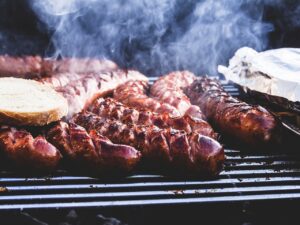Key Takeaway
| What Should My Blackstone Griddle Look Like After Seasoning? |
|---|
| – A properly seasoned Blackstone griddle should have a smooth, non-stick surface. |
| – The color of the griddle surface will transform from silver to a deep, dark hue. |
| – Well-seasoned griddles are durable, easy to clean, and resistant to rust. |
| – Regular cleaning and reseasoning will help maintain the appearance and performance. |
When it comes to cooking on a Blackstone griddle, proper seasoning is key to achieving optimal results.
Seasoning not only enhances the flavor of your dishes, but it also creates a protective layer on the griddle surface, preventing food from sticking and rust from forming.
In this article, we’ll guide you on what to expect in terms of appearance after seasoning your Blackstone griddle, ensuring a remarkable cooking experience.
Preparing the Griddle
Before you start seasoning, it’s crucial to prepare the griddle surface properly. Begin by thoroughly cleaning the griddle, removing any dirt, grease, or rust.
Use a mild detergent and a non-abrasive scrubber to get rid of any residue. Once cleaned, dry off the griddle completely to prevent water spots. A clean and dry surface provides a solid foundation for the seasoning process.
Choosing the Right Seasoning Oil
To achieve the best results, it’s important to select the right oil for seasoning your Blackstone griddle. Opt for oils rich in fatty acids, such as flaxseed oil, vegetable oil, or canola oil.
These oils polymerize when heated, creating a durable and low-maintenance surface on the griddle. Avoid using oils with low smoke points, as they can create an undesirable taste and smoke during the seasoning process.
The Seasoning Process
Now that your griddle is clean and dry, it’s time to start the seasoning process. Begin by heating up the griddle on high heat. This helps open up the pores of the metal surface, allowing the oil to penetrate more effectively.
Once the griddle is hot, pour a small amount of seasoning oil onto the surface and use a cloth or paper towel to spread it evenly. Rub the oil into the griddle, making sure to cover all areas, including the edges and corners. This will create a protective layer and promote the non-stick properties of the griddle.
Understanding the Appearance
As you season your griddle, you’ll notice a transformation in its appearance. Initially, the griddle surface may have a silver color, similar to bare metal.
However, with each additional seasoning, the surface will gradually darken, taking on a deep, dark hue. This color change indicates that the seasoning process is working and the protective layer is being formed. A properly seasoned griddle should have a smooth surface that is non-stick and easy to cook on.
Maintaining Your Seasoned Griddle
To maintain the appearance and performance of your seasoned griddle, it’s important to clean and reseason it after each use. After cooking, scrape off any food debris or residue with a grill scraper or spatula. Use warm water and a gentle scrub brush or sponge to clean the griddle surface.
Once cleaned, dry the griddle thoroughly and apply a thin layer of oil to prevent rusting. Regular cleaning and reseasoning will help keep your griddle in optimal condition.
Troubleshooting Seasoning Issues
If you encounter any issues during the seasoning process, don’t panic. It’s common to face challenges along the way. If your griddle surface appears sticky or tacky after seasoning, it may be due to excess oil or inadequate heat during the process.
To remedy this, heat the griddle again until the oil melts and wipes it clean with a cloth or paper towel. You can then start the seasoning process again, ensuring proper oil application and heating.
Real-Life Examples and Tips from Blackstone Griddle Owners
To provide you with a real-life perspective, we’d like to share some success stories and tips from Blackstone griddle owners. These individuals have mastered the art of seasoning their griddles and have experienced the benefits firsthand.
One common piece of advice is to be patient during the seasoning process. It may take several rounds to achieve the desired appearance and performance. Experimenting with different oils and seasoning techniques can also help you find what works best for your specific griddle.
Conclusion
In conclusion, a properly seasoned Blackstone griddle should have a smooth, non-stick surface that is easy to cook on. The color of the griddle surface will gradually darken with each seasoning, indicating the formation of a protective layer.
With regular cleaning and reseasoning, you can maintain the appearance and performance of your griddle, ensuring many enjoyable cooking experiences. Unlock the full potential of your Blackstone griddle by mastering the art of seasoning and enjoy the delicious results it brings to your favorite dishes.
Additional Table:
Common Seasoning Issues and Solutions
| Issue | Solution |
|---|---|
| Sticky or tacky griddle surface after seasoning | – Heat the griddle to melt the excess oil, then wipe it clean with a cloth or paper towel. |
| Uneven coloration on the griddle surface | – Ensure even distribution of oil during seasoning. |
| Smoke and unpleasant odors during seasoning process | – Use oils with high smoke points and proper ventilation during the seasoning process. |
| Rust spots appearing on the seasoned griddle surface | – Regularly clean and dry the griddle after each use, reapplying a thin layer of oil to prevent rusting. |
| Food sticking to the griddle despite seasoning efforts | – Adjust cooking techniques and temperatures or reseason the griddle. |
